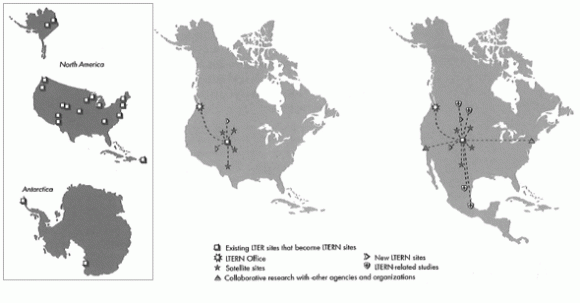Assessing the greatest opportunities and needs for the next decade
The Long-Term Ecological Research Program has now been in operation for over ten years and has excellent prospects for major expansion.
Two exercises have been completed during the last year to assess where the greatest opportunities and needs exist during the second decade of LTER.
The first of these, LTER 2000, was an internal exercise to shape our vision of future directions.
The second and far more comprehensive effort is the just-completed review of the performance of the LTER Program and its prospects for future development, conducted by an independent committee for the National Science Foundation. Their report -- Ten-Year Review of the National Science Foundation Long-Term Ecological Research (LTER) Program -- acknowledges LTER’s significant contributions to the nation’s environmental research effort. It also challenges those of us in LTER to better integrate our efforts and prepare for major expansion.
Both reviews have proposed dramatic increases in the scale and breadth of the LTER Program. The Ten-Year Review Committee recommends expansion in LTER’s breadth of geography, disciplines, and biological scale; in its level of integration; and in the application of its results to societal problems. Specific elements include:
- An enlarged system of sites, including satellite sites, to better deal with regional, continental and global patterns of ecological response
- Development of educational programs at a variety of levels and in a variety of forms
- A major commitment to the implementation of a global system of LTER-like programs
The Committee emphasizes that strong site-based science programs are basic to a future Network program, and essential to any expansion. New initiatives should be supported with new funds, not funds from existing long-term projects to which the sites have already committed themselves.
Several major challenges stand out as we move toward the greatly expanded role that we and our peers envision. An
enlarged program must:
- Develop truly integrated partnerships with other governmental organizations and institutions to ensure LTER’s success (by many different measures!)
- Dramatically increase multi-site and integrative science
- Expand interdisciplinary work across levels of biological organization, incorporating more physical and (perhaps the greatest challenge) more social scientists
- Foster the development of a global program of long-term research
An area of immediate concern, which appears several times in the Ten-Year Review Report and in our own planning documents, is the comparability of scientific data across the Network. There is an obvious need to increase standardization in parameters and sampling protocols across sites, to design and implement quality control procedures, and to increase the number of comparable datasets suitable for intersite comparisons.
Though there are some notable exceptions in the areas of data management, remotely-sensed data, litter decomposition, and meteorology, in moments of candor many of us will admit that the numbers of existing comparable data sets or data sets currently being collected across the Network are embarrassingly few. On this issue, the LTER Ten-Year Review Committee is very clear: “. . . standardization of measurements and agreement of a minimum data set have not been fully developed. . . the possibility for cross-site comparisons addressing the five [core] topics has been limited by lack of comparable data sets.”
“The challenge for the next decade is to maintain our high-quality effort, while creating the greater ‘LTERN’ identified by the Ten-Year Review”
While there is agreement that this area requires our serious attention, there is little agreement among LTER scientists on how to proceed. Some agree on a common set of parameters for at least some logical subsets of the sites. Others emphasize the need for sampling protocols for the collection of specific data types. Most of us want the selection of parameters to be driven primarily by questions or hypotheses, broadly interpreted.
How, then, do we improve the convertibility and comparability of the data collected across the Network or significant subsets of sites?
At a July meeting in Madison, Wisconsin to consider the recommendations of the Review, the LTER Coordinating Committee proposed to begin by addressing standardization of parameters, protocols, or cross-site questions by topical areas.
This September at the LTER All Scientists Meeting in Estes Park, Colorado, groups interested in soil measurements, biodiversity, primary productivity, stream measurements, landscape, tree population dynamics, and decomposition, among other areas, will meet to discuss creating comparable LTER data sets. No single approach has been prescribed or proscribed. However, it is understood that parameters should be identified, based either on questions or logical need, and that protocols, whether for collection of data or quality control, should be considered. Hopefully, this bottom-up approach will be more fruitful than the top- down approaches employed thus far.
The first decade (actually 12 years) of LTER has resulted in an extraordinarily productive scientific program, a program recognized as a leader in the creation of relevant scientific knowledge, including the collection of long-term data sets. The challenge for the next decade is to maintain our high-quality effort, while creating the greater “LTERN” identified by the Ten-Year Review.


 Enlarge this image
Enlarge this image